-
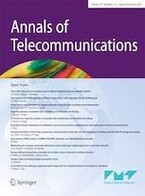
Performance evaluation of an active signaling based time-slot scheduling scheme for connected vehicles. Annals of Telecommunications
Boukhalfa, F., Hadded, M., Muhlethaler, P., & Shagdar, O.
(2021). ArticleAnnals of Telecommunications. No.76, pp. 363–374
Latency is a very important metric to be taken into account in the design of the Connected and Automated Driving (CAD) technology. Today, connected vehicles have a dedicated technology named vehicle-to-everything (V2X). Many current research efforts and standardization activities aim to make the next generation of V2X technology able to offer new usages and services, with the main focus being on supporting road safety applications: hazard, obstacle and collision avoidance, etc. To satisfy the real-time constraints of safety applications, Time Division Multiple Access (TDMA) is a widely-used technique to control and share the channel. TDMA-based Medium Access Control (MAC) protocols have...
Latency is a very important metric to be taken into account in the design of the Connected and Automated Driving (CAD) technology. Today, connected vehicles have a dedicated technology named vehicle-to-everything (V2X). Many current research efforts and standardization activities aim to make the next generation of V2X technology able to offer new usages and services, with the main focus being on supporting road safety applications: hazard, obstacle and collision avoidance, etc. To satisfy the real-time constraints of safety applications, Time Division Multiple Access (TDMA) is a widely-used technique to control and share the channel. TDMA-based Medium Access Control (MAC) protocols have resolved many issues in VANETs and shown good performances in the literature by ensuring a bounded access delay to send an emergency message. However, latency can be further improved by eradicating some imperfections in the functionality of these protocols, such as the access collision problem which can occur when two or more vehicles in the same two-hop neighborhood set try to access the same slot at the same time. That is why we recently proposed an Active Signaling-based TDMA MAC protocol, called AS-DTMAC, which operates above the existing DTMAC protocol. In this paper, we analytically study the performance of AS-DMTAC when we have a homogeneous arrival on each time slot with an error in the signaling process.
Read more Hide DOI: https://doi.org/10.1007/s12243-020-00818-8 -
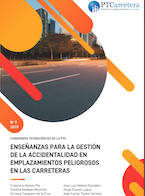
Enseñanzas para la gestión de la accidentalidad en emplazamientos peligrosos en las carreteras
Francisco Alonso, Cristina Esteban, Enrique Casquero, Jose Luis Velarte, Jorge Suarez, Juan Carlos Pastor
(2020). LlibreCuadernos Tecnológicos de la PTC. No.3 (2019)
This document has focused on expressing the fundamental need, common to all countries, to act on dangerous sites (referred to by the scientific literature with a myriad of terms), and precisely in this sense, to develop policies aimed at the proper implementation of road safety management systems (both in the design phase and in the operation phase, as stated in such important framework documents as the European Directive 2019/1936). The objective is clear: work must be done to achieve the Safe System concept, in which road engineers ensure that the road network has been designed and maintained from a safety perspective. It is hoped that this document will be useful not only for its...
This document has focused on expressing the fundamental need, common to all countries, to act on dangerous sites (referred to by the scientific literature with a myriad of terms), and precisely in this sense, to develop policies aimed at the proper implementation of road safety management systems (both in the design phase and in the operation phase, as stated in such important framework documents as the European Directive 2019/1936). The objective is clear: work must be done to achieve the Safe System concept, in which road engineers ensure that the road network has been designed and maintained from a safety perspective. It is hoped that this document will be useful not only for its informative nature, but also for its practical character, since it can serve as a reference for all the actors who decide to face the problem of accidents from the point of view of the management of dangerous sites, thanks to the adoption of successful strategies and the possibility of "avoiding" the mistakes learned from experience. S'espera que el present document no només sigui d'utilitat pel seu caràcter divulgatiu, sinó també pel seu caràcter pràctic, ja que pot servir de referència a tots els actors que decideixin fer front a la problemàtica de l'accidentalitat des del punt de vista de la gestió d'emplaçaments perillosos, gràcies a l'adopció d'estratègies d'èxit ia la possibilitat de "esquivar" els errors apresos de l'experiència.
Read more Hide ISBN: 978-84-09-21202-6 -
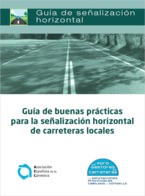
Guía de buenas prácticas para la señalización horizontal de carreteras locales
ed. Asociación Española de la Carretera (AEC); Foro de Gestores de Carreteras, de Diputaciones provinciales, Cabildos y Consells.
(2020). LlibreGuía de buenas prácticas para la señalización horizontal de carreteras locales.
Technical document, developed by experts in horizontal signaling, together with the Spanish Road Association, as a guide structured in two parts: 1) Horizontal signaling of local roads, and 2) improvement of the circulation and safety on local roads through horizontal signaling (situations and solutions).
-

Multi-Objective Decision Support System for Intelligent Road Signaling
Domínguez, J. M. L., Sanguino, T. D. J. M., Véliz, D. M., & de Viana González, I. J. F.
(2020). Article15th Iberian Conference on Information Systems and Technologies (CISTI). No.pp.1-6
Currently, Doppler radars are widely used to detect and identify targets in different knowledge fields such as aerospace, medical or road safety. In this paper, a novel decision support system that relies on this kind of radars is presented. The aim of this system is to propose a time-frequency algorithm based on micro-Doppler signatures to detect and identify complex moving targets on public roads. Before obtaining this signature, each radar signal is improved using pre-processing techniques. Then, the short-time Fourier transform is applied to analyse and represent each signal received from the radar. Finally, different scenarios including pedestrians, vehicles and cyclists were used to...
Currently, Doppler radars are widely used to detect and identify targets in different knowledge fields such as aerospace, medical or road safety. In this paper, a novel decision support system that relies on this kind of radars is presented. The aim of this system is to propose a time-frequency algorithm based on micro-Doppler signatures to detect and identify complex moving targets on public roads. Before obtaining this signature, each radar signal is improved using pre-processing techniques. Then, the short-time Fourier transform is applied to analyse and represent each signal received from the radar. Finally, different scenarios including pedestrians, vehicles and cyclists were used to demonstrate the performance of our system in target detection. The results have validated that pedestrians can be correctly identified only relying on their micro-Doppler signatures. As an example, this paper presents several use cases in which pedestrian signatures are characterized by vertical lines unlike vehicles and cyclists where signatures have horizontal lines characterized by larger vertical strips.
Read more Hide DOI: https://doi.org/10.23919/CISTI49556.2020.9141083 -
Resolución Regulatoria Núm. 005-2020 [que regula la señalización en el tránsito terreste]
República Dominicana. Instituto Nacional de Tránsito y Transporte Terrestre.
(2020). InformesResolución regulatoria. No.005-2020
The "SEOFER Chair of Road Safety and Intelligent Mobility" has provided support in updating the designs of the signs of the 1983 Manual to more modern and visual designs for the Dominican Republic, which has resulted in this Regulatory Resolution No. 005-2020, which regulates the Signaling in Land Traffic and which aims to update and improve both the general criteria and the specific criteria for the design and placement of the first two groups of signs established in Article 7 of Article 7 of the Road Traffic Law. 005-2020, which regulates the Signaling in Land Traffic and which aims to update and improve both the general criteria and the specific criteria for design and placement of the...
The "SEOFER Chair of Road Safety and Intelligent Mobility" has provided support in updating the designs of the signs of the 1983 Manual to more modern and visual designs for the Dominican Republic, which has resulted in this Regulatory Resolution No. 005-2020, which regulates the Signaling in Land Traffic and which aims to update and improve both the general criteria and the specific criteria for the design and placement of the first two groups of signs established in Article 7 of Article 7 of the Road Traffic Law. 005-2020, which regulates the Signaling in Land Traffic and which aims to update and improve both the general criteria and the specific criteria for design and placement of the first two groups of signs established in Article 7 of the Regulation of Signaling in Land Traffic and which are Vertical Signaling and Horizontal Signaling (road markings).
Read more Hide -

Norma de Carreteras 8.2-IC Marcas Viales
España. Ministerio de Transportes, Movilidad y Agenda Urbana.
(2020). LlibreNorma de Carreteras 8.2-IC Marcas Viales.
Normative, technical document, currently in its drafting stage (published in 2020), which updates de current norm regulating the approved road markings in the Ministerial Order from July 16th, 1987. The update of the current norm on road markings, with the main objective of increasing every road user’s safety and comfort, especially the most vulnerable ones, has been crafted taking into account a series of factors: the evolution of both the road network and the car pool, as well as the drivers’ habits; the increasing presence and importance given to the protection of vulnerable users, among which pedestrians and cyclists particularly stand out; and the experience accumulated during the...
Normative, technical document, currently in its drafting stage (published in 2020), which updates de current norm regulating the approved road markings in the Ministerial Order from July 16th, 1987. The update of the current norm on road markings, with the main objective of increasing every road user’s safety and comfort, especially the most vulnerable ones, has been crafted taking into account a series of factors: the evolution of both the road network and the car pool, as well as the drivers’ habits; the increasing presence and importance given to the protection of vulnerable users, among which pedestrians and cyclists particularly stand out; and the experience accumulated during the past decades by different administrations and countries, allowing for the disposition of new designs, geometries and types of brands
Read more Hide(actualización 2020, borrador)
-
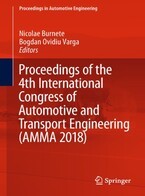
The significance and effect of the traffic system signaling to the environment, present and future traffic
Lengyel, H., & Szalay, Z.
(2018). ArticleInternational Congress of Automotive and Transport Engineering.
The development of automotive technologies brings new features such as the emergence of autonomous vehicles and an advanced infrastructure, but is a big challenge for the professionals. In this paper we present the currently used signs on the different road sections. We describe the significance of signaling systems for the present and future traffic, especially from the point of view road safety and environment. We analyzed the used traffic signs recognition systems how them can identify the signals in the traffic. Particular emphasis is placed on the benefits, the importance and the problems that arise in recognizing systems. We will propose their development opportunities, and these will...
The development of automotive technologies brings new features such as the emergence of autonomous vehicles and an advanced infrastructure, but is a big challenge for the professionals. In this paper we present the currently used signs on the different road sections. We describe the significance of signaling systems for the present and future traffic, especially from the point of view road safety and environment. We analyzed the used traffic signs recognition systems how them can identify the signals in the traffic. Particular emphasis is placed on the benefits, the importance and the problems that arise in recognizing systems. We will propose their development opportunities, and these will affect the pre-emergence period of fully autonomous vehicles when the vehicles are on lower autonomy level but at the same time the higher autonomy level vehicles are appear in the traffic. It has difficulties with the recognition systems and the emergence of autonomous vehicles. There may be problems with systems in different signaling systems. There are some other problems what need to find solution for example is the legal rules to the autonomous vehicles and different country has different looking traffic signs what is hard to recognize to the systems.
Read more HideEn: Burnete N., Varga B. (eds) Proceedings of the 4th International Congress of Automotive and Transport Engineering (AMMA 2018). pp. 847-856
-
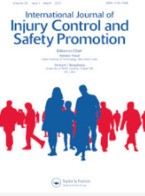
The impact of traffic sign deficit on road traffic accidents in Nigeria
Ezeibe, C., Ilo, C., Oguonu, C., Ali, A., Abada, I., Ezeibe, E. & Agbo, H. [et al]
(2018). ArticleInternational journal of injury control and safety promotion.
This study assesses the impact of traffic sign deficit on road traffic accidents in Nigeria. The participants were 720 commercial vehicle drivers. While simple random sampling was used to select 6 out of 137 federal highways, stratified random sampling was used to select six categories of commercial vehicle drivers. The study used qual-dominant mixed methods approach comprising key informant interviews; group interviews; field observation; policy appraisal and secondary literature on traffic signs. Result shows that the failure of government to provide and maintain traffic signs in order to guide road users through the numerous accident black spots on the highways is the major cause of road...
This study assesses the impact of traffic sign deficit on road traffic accidents in Nigeria. The participants were 720 commercial vehicle drivers. While simple random sampling was used to select 6 out of 137 federal highways, stratified random sampling was used to select six categories of commercial vehicle drivers. The study used qual-dominant mixed methods approach comprising key informant interviews; group interviews; field observation; policy appraisal and secondary literature on traffic signs. Result shows that the failure of government to provide and maintain traffic signs in order to guide road users through the numerous accident black spots on the highways is the major cause of road accidents in Nigeria. The study argues that provision and maintenance of traffic signs present opportunity to promoting safety on the highways and achieving the sustainable development goals.
Read more Hide -
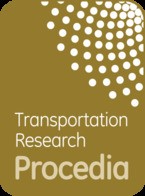
Road safety awareness and comprehension of road signs from international tourist’s perspectives: a case study of Thailand
Choocharukul, K., & Sriroongvikrai, K.
(2017). ArticleTransportation research procedia. No.25, pp. 4518-4528.
Under foreign environment, tourists could drive in unfamiliar surroundings, misunderstand and misinterpret traffic signs, or even violate local traffic laws. This study attempts to explore tourist’s perceptions and awareness regarding road safety and investigate underlying factors that could affect tourist’s comprehension of local road signs. A survey questionnaire was distributed to 1,091 international tourists visiting Thailand. Results indicate that the level of perceptions and awareness regarding road safety were found to be different among tourists with different origins. In addition, respondents could only comprehend road signs to some extent, e.g. text traffic signs such as stop sign...
Under foreign environment, tourists could drive in unfamiliar surroundings, misunderstand and misinterpret traffic signs, or even violate local traffic laws. This study attempts to explore tourist’s perceptions and awareness regarding road safety and investigate underlying factors that could affect tourist’s comprehension of local road signs. A survey questionnaire was distributed to 1,091 international tourists visiting Thailand. Results indicate that the level of perceptions and awareness regarding road safety were found to be different among tourists with different origins. In addition, respondents could only comprehend road signs to some extent, e.g. text traffic signs such as stop sign and yield sign seemed to be difficult to understand from tourist’s perspectives. Statistical modeling results reveal a set of significant factors affecting the level of traffic sign comprehension. Significant socio-economic variables consist of respondent’s age, driver’s license ownership, respondent’s driving experience in foreign countries, and respondent’s nationality. On the other hand, the significant travel characteristic variables are trip duration, trip objective, mode of transportation, and frequency of visit. Findings would help highway and traffic authorities in better understanding tourist’s travel behavior and contribute to road safety design standards serving both local and foreign users.
Read more Hide -
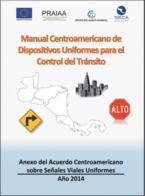
Manual de Dispositivos Uniformes para el Control del Tránsito
Secretaría de Integración Económica Centroamericana (SIECA)
(2015). LlibreManual de Dispositivos Uniformes para el Control del Tránsito.
Technical document, update of the previous Agreement signed by several countries from the Central American region, which aims at establishing an adequate unification of regional road signs for pedestrian and vehicle traffic, as well as an efficient use of traffic control devices, rules that justify their use, technical aspects of horizontal and vertical signaling, pavement islands, traffic lights, traffic control and safety devices, and an updated catalogue of signals. All of this with the objective of facilitating and guaranteeing an ordered, safe, and predictable circulation of all users on Central American roads.






